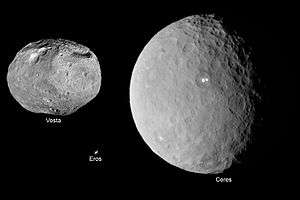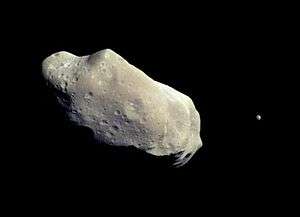Don Quijote (spacecraft)
| Mission type | Orbiter, impactor, and lander |
|---|---|
| Operator | European Space Agency |
| Website | Don Quijote concept |
| Spacecraft properties | |
| Bus | Modified SMART-1[1] |
| Launch mass |
Orbiter: 491 kg (1,082 lb) Lander: 1,694 kg (3,735 lb) |
| Dry mass |
Orbiter: 395 kg (871 lb) Lander: 532 kg (1,173 lb) |
| Payload mass |
Orbiter: 20.6 kg (45 lb) Lander: 9 kg (20 lb) |
| Start of mission | |
| Launch date | Studied for a 2015 launch |
| Orbital parameters | |
| Reference system | Heliocentric |
| 2003 SM84 or 99942 Apophis[2] orbiter | |
| Spacecraft component | Sancho |
| Orbits | Months |
| 2003 SM84 or 99942 Apophis[2] impactor | |
| Spacecraft component | Hidalgo |
| 2003 SM84 or 99942 Apophis[2] lander | |
| Spacecraft component | Autonomous Surface Package |
| Orbits | Months |
Don Quijote is a past space probe concept that has been studied by the European Space Agency, and which would investigate the effects of crashing a spacecraft into an asteroid. The mission was intended to test whether a spacecraft could successfully deflect an asteroid on a collision course with Earth. The orbiter was designed to last for seven years. The mission did not proceed beyond initial studies, currently ESA is working on Asteroid Impact & Deflection Assessment mission as a part of its NEO space mission studies.[3]
Overview
The mission would consist of two spacecraft that will execute a series of maneuvers around a small, 500-metre (1,600-foot) asteroid.[3]
- The first spacecraft, Sancho, will arrive at the asteroid and orbit it for several months, studying it. The orbiter will use a single xenon ion engine.
- After a few months, the second spacecraft, Hidalgo, will hurtle toward the asteroid on a collision course. It will sleep for most of the trip and then steer itself using optical sensors with an accuracy of 50 meters. Sancho will retreat to a safe distance while Hidalgo will hit the asteroid at around 10 km/s.
- Sancho will then return to its close orbit and see how much the asteroid's shape, internal structure, orbit and rotation have been affected by the impact.[1]
- Sancho will release the Autonomous Surface Package, a Lander which will free-fall toward the asteroid for 2 hours before landing. This package will be directed towards the interior of the impact crater where it will investigate properties of the surface.
Don Quijote was one of six Near Earth Object precursor studies funded by ESA's General Studies Programme, other missions being: EUNEOS (European NEO Survey), Earthguard-I, NERO (NEO Remote Observations), SIMONE (Smallsat Intercept Missions to Objects Near Earth) and ISHTAR (Internal Structure High-resolution Tomography by Asteroid Rendezvous).[4]
Propulsion
The craft would be launched by a Vega launcher and a Star 48 upper stage. The ESA considered two design options: the "Cheap Option" using a chemical propulsion system, and the "Flexible Option" using an electric propulsion system. The former would be targeted to the Amor asteroid 2003 SM84, the latter to the asteroid 99942 Apophis.[2]
Instrumentation
Sancho (orbiter)
The instruments on the orbiter are classified into those essential to the success of the mission and those for the completion of extended mission objectives. The primary instruments are the Radio Science Experiment, Orbiter Camera, Imaging Laser Altimeter, and a LIDAR instrument. For the extended mission objectives, the orbiter carries an IR Spectrometer, a Thermal IR Imager, an X-Ray Spectrometer, a Radiation Monitor and the Autonomous Surface Package (ASP).[1]
Hidalgo (impactor)
Unlike many other spacecraft, the goal of the Hidalgo impactor is to be as massive as possible upon reaching the target asteroid; because of this goal, the propulsion module is not jettisoned after use. The impactor carries few subsystems to make it as low-cost and maneuverable as possible. It has no moving appendages (solar panels, etc.) to complicate orientation, it uses only its RCS thrusters for course corrections, and it has a high-resolution targeting camera for ~50 m targeting accuracy on impact. The LISA Pathfinder design was considered as an initial design reference.[1]
Target
Originally, the ESA identified two near-Earth asteroids as possible targets: 2002 AT4 and (10302) 1989 ML. Neither asteroid represents a threat to Earth.[2] In a subsequent study, two different possibilities were selected: the Amor asteroid 2003 SM84 and 99942 Apophis; the latter is of particular significance to Earth as it will make a close approach in 2029 and 2036.[2]
In 2005, the proposed mission was combined with AIDA, with the target selected as a binary asteroid, so that the effect of the deflection can be seen even from Earth by observing the period of the binary. The targets were 2002 AT4 and (10302) 1989 ML.[5]
The current target for AIDA is the binary asteroid 65803 Didymos.[6][7][8]
Names
The mission is named after the fictional Spanish knight from Miguel de Cervantes' renowned novel, Don Quixote, who charged against a windmill, thinking it to be a giant. Like Quixote, the Hidalgo spacecraft will 'attack' an object much larger than itself, hopefully with more impressive results. 'Sancho' is named after Sancho Panza, the Quixote's squire, who preferred to stay back and watch from a safe distance, which is the role assigned to that probe. Finally, the name Hidalgo was a minor Spanish title (roughly equivalent to a Baronet), now obsolete. In the novel, it was the title Alonso Quijano had even before becoming Don Quijote.
See also
- List of asteroids visited by spacecraft
- Spacecraft
- AIDA - planned ESA asteroid impact probe
- Deep Impact - completed NASA comet impactor mission (2005)
- Hayabusa 2 - en-route JAXA probe
- SMART-1 - completed ESA lunar impact probe (2006)
References
- 1 2 3 4 "Don Quixote concept". ESA. Retrieved 17 June 2015.
- 1 2 3 4 5 6 "Sancho study: designing the minimum Earth escape spacecraft". ESA. 23 May 2012. Retrieved 17 June 2015.
- 1 2 "Past studies: Don Quijote". ESA. Retrieved 17 June 2015.
- ↑ "NEO precursor studies". ESA. 26 February 2015. Retrieved 17 June 2015.
- ↑ "N° 41–2005: ESA selects targets for asteroid-deflecting mission Don Quijote" (Press release). ESA. 26 September 2005. Retrieved 17 June 2015.
- ↑ "Asteroid Impact Deflection Assessment AIDA study". ESA. 26 February 2015. Retrieved 17 June 2015.
- ↑ "Asteroid deflection mission seeks smashing ideas". ESA. 15 January 2013. Retrieved 17 June 2015.
- ↑ "Asteroid Deflection Mission AIDA Set To Crash Two Spacecraft Into Space Rock In 2022". Huffington Post. 25 March 2013. Retrieved 17 June 2015.
Further reading
- Gil-Fernández, J.; Panzeca, R.; Corral, C. (2008-10-15). "Impacting small Near Earth Objects". Advances in Space Research. 42 (8): 1352. Bibcode:2008AdSpR..42.1352G. doi:10.1016/j.asr.2008.02.023.
External links
- ESA News: ESA selects targets for asteroid-deflecting mission Don Quijote. ESA PR 41-2005.
- Don Quijote Asteroid Deflection Mission video


